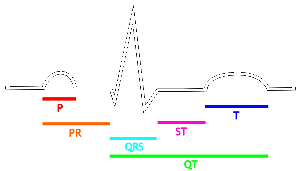Cardiac electrophysiology: Difference between revisions
No edit summary |
No edit summary |
||
| Line 113: | Line 113: | ||
{{Electrocardiography}} | {{Electrocardiography}} | ||
{{Circulatory system pathology}} | |||
{{SIB}} | {{SIB}} | ||
[[Category:Electrophysiology]] | [[Category:Electrophysiology]] | ||
[[Category:Emergency medicine]] | [[Category:Emergency medicine]] | ||
Revision as of 18:30, 25 January 2009
| Cardiac electrophysiology | |
 | |
|---|---|
| Drawing of the EKG, with labels of intervals |
| Cardiology Network |
 Discuss Cardiac electrophysiology further in the WikiDoc Cardiology Network |
| Adult Congenital |
|---|
| Biomarkers |
| Cardiac Rehabilitation |
| Congestive Heart Failure |
| CT Angiography |
| Echocardiography |
| Electrophysiology |
| Cardiology General |
| Genetics |
| Health Economics |
| Hypertension |
| Interventional Cardiology |
| MRI |
| Nuclear Cardiology |
| Peripheral Arterial Disease |
| Prevention |
| Public Policy |
| Pulmonary Embolism |
| Stable Angina |
| Valvular Heart Disease |
| Vascular Medicine |
Editor-In-Chief: C. Michael Gibson, M.S., M.D. [1]
Please Take Over This Page and Apply to be Editor-In-Chief for this topic: There can be one or more than one Editor-In-Chief. You may also apply to be an Associate Editor-In-Chief of one of the subtopics below. Please mail us [2] to indicate your interest in serving either as an Editor-In-Chief of the entire topic or as an Associate Editor-In-Chief for a subtopic. Please be sure to attach your CV and or biographical sketch.
Overview
Cardiac electrophysiology (also referred to as clinical cardiac electrophysiology , Arrhythmia Services , or electrophysiology) is the science of the mechanisms, functions, and performance of the electrical activities of specific regions of the heart.
An electrophysiologic study is a term used to describe a number of invasive (intracardiac) and non-invasive recording of spontaneous electrical activity as well as of cardiac responses to programmed electrical stimulation. These studies are performed to assess arrhythmias, elucidate symptoms, evaluate abnormal electrocardiograms, assess risk of developing arrhythmias in the future, and design treatment. These procedures increasingly include therapeutic methods (typically radiofrequency ablation) in addition to diagnostic and prognostic procedures. Other therapeutic modalities employed in this field include antiarrhythmic drug therapy and implantation of pacemakers and implantable cardioverter-defibrillators.
A specialist in cardiac electrophysiology is known as a cardiac electrophysiologist, or (more commonly) simply an electrophysiologist. Cardiac electrophysiology is considered a subspecialty of cardiology, and in most countries requires two or more years of fellowship training beyond a general cardiology fellowship. They are trained to perform interventional cardiac EP procedures as well as surgical device implantations.
Diagnostic testing
- Ambulatory electrocardiographic monitoring - Holter recording and interpretation, loop recording and interpretation;
- Tilt table testing;
- Signal-averaged electrocardiogram (SAECG) interpretation, also referred to as "late potentials" reading;
- Electrophysiologic study (EPS) consists in the insertion of pacing and recording electrodes either in the oesophagus (intra-oesophageal EPS) or, through blood vessels, directly into the heart chambers (intra-cardiac EPS) in order to measure electrical properties of the heart and, in the case of intra-cardiac EPS, to electrically stimulate it in the attempt to induce arrhythmias for diagnostic purposes ("programmed electrical stimulation").
Medical treatment
- Initital administration and monitoring of the effect of drugs for treatment of heart rhythm disorders. Electrophysiologists are often involved when severe or life threatening arrhythmias are being treated, or when multiple drugs must be used to treat an arrhythmia.
Catheter ablation
- Ablation therapy - Catheter based creation of lesions in the heart (with radiofrequency energy, cryotherapy (destructive freezing), or ultrasound energy) to cure or control arrhythmias (see radiofrequency ablation). Ablation is usually performed during the same procedure as the electrophysiology study which induces and confirms the diagnosis of the arrhythmia for which ablation therapy is sought.
- "Non-complex" ablations include ablation for arrhythmias such as: AV nodal reentrant tachycardia, Accessory pathway mediated tachycardia, atrial flutter. These procedures are usually performed using intracardiac catheters (as are used during an electrophysiologic study), fluoroscopy (a real-time X-ray camera), and electrical recordings from the inside of the heart.
- "Complex" ablations include ablation for arrhythmias such as multifocal atrial tachycardia, atrial fibrillation, and ventricular tachycardia. In addition to the apparatus used for a "non-complex" ablation, these procedures often make use of sophisticated computer mapping systems to localize the source of the abnormal rhythm and to direct delivery of ablation lesions.
Surgical Procedures: Pacemaker and Defibrillator implantation and follow up
- Implantation of single and dual chamber pacemakers and defibrillators
- Implantation of "biventricular" pacemakers and defibrillators for patients with congestive heart failure
- Implantation of loop recorders (implanted ECG recorders for long term monitoring of ECG to allow for diagnosis of an arrhythmia)
- Clinical follow up and reprogramming of implanted devices
Scope of practice, tests and procedures:
Normal Cardiac Action Potential
Mechanism of Arrhythmias
Antiarrhythmic Medications
EP study basics
Diseases of the Conduction System and Bradyarrhythmias
Narrow Complex Tachycardias
Atrial Flutter
Atrial Fibrillation
Atrial Tachycardia
AV Nodal Reentrant Tachycardia
Circus Movement Tachycardia
Wide Complex Tachycardias
WPW Syndrome
Ventricular Tachycardia
Ventricular Tachyarrhythmias in Structurally Normal Hearts
Brugada Syndrome
Long QT Syndrome
Ventricular Tachyarrhythmias, Cardiac Arrest and Sudden Cardiac Death
Syncope
Indications for Pacemakers
Indications for an ICD
Cardiac Resynchronization Therapy
Arrhythmias in Pregnancy
See also
- Clinical cardiac electrophysiology
- Electrical conduction system of the heart
- Electrocardiogram (EKG)
- Electrophysiologic study
- Cardiology
- Cardiac arrhythmia
External links